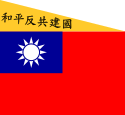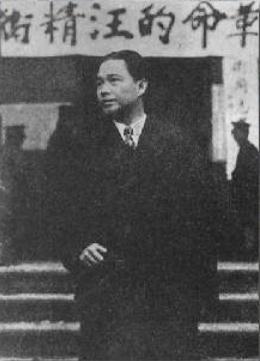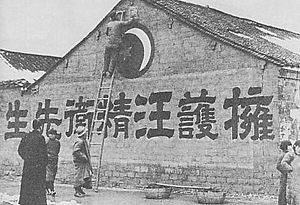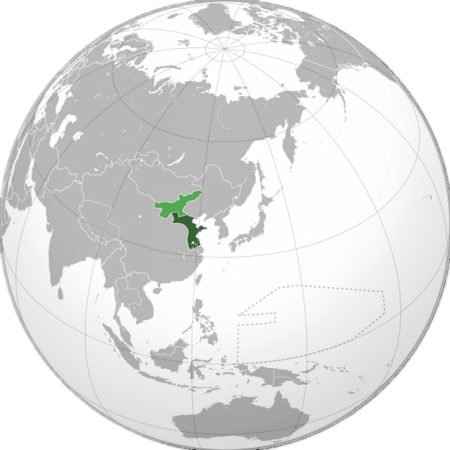Wang Jingwei regime facts for kids
Quick facts for kids
Republic of China
|
|||||||||||||||
|---|---|---|---|---|---|---|---|---|---|---|---|---|---|---|---|
| 1940–1945 | |||||||||||||||
|
Motto: 和平反共建國
"Peace, Anti-Communism, Nation building" |
|||||||||||||||
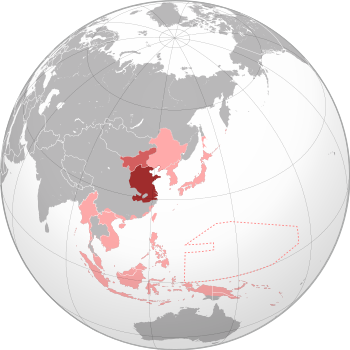
The Wang Jingwei regime (dark red) and Mengjiang (light red) within the Empire of Japan (pink) at its furthest extent
|
|||||||||||||||
| Status | Puppet state of the Empire of Japan | ||||||||||||||
| Capital | Nanking | ||||||||||||||
| Largest city | Shanghai | ||||||||||||||
| Official languages | Mandarin Japanese |
||||||||||||||
| Government | Fascist one-party dictatorship | ||||||||||||||
| President | |||||||||||||||
|
• 1940–1944
|
Wang Jingwei | ||||||||||||||
|
• 1944–1945
|
Chen Gongbo | ||||||||||||||
| Vice President | |||||||||||||||
|
• 1940–1945
|
Zhou Fohai | ||||||||||||||
| Historical era | World War II | ||||||||||||||
|
• Established
|
30 March 1940 | ||||||||||||||
|
• Recognized by Japan
|
20 November 1940 | ||||||||||||||
| 16 August 1945 | |||||||||||||||
|
|||||||||||||||
| Today part of | China | ||||||||||||||
The Reorganized National Government of the Republic of China was a government set up by Japan in eastern China during World War II. It is often called the Wang Jingwei regime after its leader, Wang Jingwei. This government was a "puppet state" of Japan. This means Japan controlled it, even though it looked like an independent country.
This government should not be confused with the main Republic of China government. That government, led by Chiang Kai-shek, was fighting against Japan. Wang Jingwei, a former high-ranking Chinese official, decided to work with Japan. He formed this new government in Nanjing in 1940. Nanjing was the traditional capital of China.
The Wang Jingwei regime claimed to rule all of China. However, it only truly controlled areas that Japan had taken over. Other countries mostly saw it as a Japanese puppet. It existed until Japan lost World War II in August 1945. After the war, the government was dissolved. Many of its leaders were put on trial.
This new state was created by combining two earlier Japanese-controlled governments. These were the Reformed Government and the Provisional Government. These earlier governments had ruled parts of central and northern China. Wang Jingwei's government had very limited power from Japan. This only slightly changed with a new agreement in 1943.
Contents
What Was This Government Called?
The Wang Jingwei regime had several names. People often called it the Nanjing Nationalist Government or the Nanjing Regime. It was also known as the Wang Jingwei Regime, named after its leader.
In China, many people saw it as an illegal government. They called it Wang's Puppet Regime or Puppet Nationalist Government. Other names included Republic of China-Nanjing or New China.
How Was This Government Formed?
Wang Jingwei was once a very important leader in China's Nationalist Party. He was even thought to be a possible successor to Sun Yat-sen, a key figure in Chinese history. By the 1930s, Wang was China's Minister of Foreign Affairs. He was in charge of China's relationship with Japan.
Wang Jingwei tried hard to keep peace with Japan. He believed China needed peace to grow stronger. But Japan invaded China, starting the Second Sino-Japanese War. Wang wanted to make a peace deal with Japan. He felt China should only agree if its land was not taken.
However, Chiang Kai-shek, China's leader, refused to surrender. He believed China could defeat Japan if it was united. So, Chiang focused on fighting the Chinese Communists. In December 1938, Wang Jingwei left Chiang's government. He went to Hanoi to find another way to end the war.
From Hanoi, Wang started talking with the Japanese. He wanted to create a new Chinese government. He hoped this government could make peace with Japan. Wang also tried to show that Chiang Kai-shek's government was not truly following Sun Yat-sen's ideas.
In August 1939, Wang secretly formed a new branch of the Nationalist Party. This new group worked with the Japanese. On March 30, 1940, Wang Jingwei officially set up his new government in Nanjing. He hoped Japan would eventually agree to a peace deal.
To show his government was legitimate, Wang visited Sun Yat-sen's tomb. He used Sun's flag to claim he was the rightful leader. But Wang's efforts were hurt early on. A diplomat named Gao Zongwu, who helped Wang, became disappointed. He revealed that Japan did not see China as an equal partner. This made Wang's government look like Japanese puppets.
Important Events and Changes
Shanghai as a Key City
Nanjing was badly damaged by the Japanese invasion. So, the new government used Shanghai as its main center. Shanghai was important for business and media. It was also safer from attacks.
The new government quickly took control of newspapers that supported Wang. They also used violence against rival news groups. By late 1940, they began taking over Chinese courts and banks. These had been controlled by Chiang Kai-shek's government or Western powers.
The government even issued a new currency. But Japan limited its use to areas they fully controlled.
Seeking More Recognition from Japan
In November 1940, Wang signed a "basic treaty" with Japan. But this treaty gave his government almost no real power. Wang could not act as a go-between with Chiang Kai-shek. His government also had little power in Japanese-occupied China.
Japanese officials saw Wang's government as unimportant. They told their representatives to ignore Wang's diplomatic efforts. Wang went to Tokyo in June 1941 to ask for more power. But Japan was focused on the war. They only offered a loan and more independence, which never happened. However, Wang did get Japan to help his government get official recognition from other Axis powers.
Gaining More Power in 1943
As the war turned against Japan, they needed more help. By 1943, Japanese leaders decided to fully recognize Wang Jingwei's government. They signed a new agreement. This gave the Nanjing government more control over its own land. It also allowed them to make more decisions.
However, this change came too late. The government did not have enough resources to use its new powers. Japan was also not in a position to offer much help.
Control Over Northern China
Some areas in northern China were under Japanese military control. These areas, like Shandong and Hebei, were technically part of Wang's government. But in reality, the Japanese army controlled them. The region of Mengjiang (in Inner Mongolia) was also only officially under Wang's government.
Government and How It Worked
Wang Jingwei was the main leader of the government. He was Chairman of the Central Political Committee and President. After he died in 1944, Chen Gongbo took over. Wang's party was the only ruling party.
The real power, however, stayed with the Japanese army. Japanese advisors also had a lot of influence. The government tried to act like the old Chinese Nationalist government. It often tried to bring back old policies.
International Recognition
The Nanjing government was not recognized by many countries. Most saw it as a Japanese puppet. Only Japan and the other Axis powers recognized it. Japan itself waited eight months before officially recognizing it in November 1940.
The United States and Britain immediately said the government was a tool of Japanese imperialism. In July 1941, Germany and Italy recognized it. Later, countries like Spain, Slovakia, and Romania also recognized it. The Nanjing government also joined the Anti-Comintern Pact in 1941.
The Holy See (Vatican City) refused to recognize the Nanjing regime. French diplomats also stayed loyal to Chiang Kai-shek's government. In 1943, the Nanjing government signed a treaty with Japan. This treaty ended foreign control over parts of China. Wang Jingwei also attended the Greater East Asia Conference as China's representative.
The Wang Jingwei government even sent Chinese athletes to compete in the 1940 East Asian Games in Tokyo.
What the Government Believed In
Wang Jingwei's government promoted the idea of pan-Asianism. This idea was about Asian countries uniting against Western powers. They wanted to create a "New Order in East Asia." This new order would include Japan, China, and other Asian nations. They believed it would remove Western colonial powers from Asia.
Wang Jingwei used the ideas of Sun Yat-sen to support his actions. He said it was natural for Japan and China to work together. He claimed their conflicts were just temporary. The government believed that Asian nations should unite under Japan's leadership. This was seen as the only way to remove Western control.
From 1940, the government said World War II was a fight by Asians against the West. They focused on the U.S. and Britain. The government had a Propaganda Ministry. It controlled local media. They used it to spread anti-Western messages. They also praised Germany and its technological progress. Wang Jingwei and other officials also shared anti-Jewish views.
The government tried to stop the spread of Western culture in China. They promoted traditional Chinese culture, especially Confucianism. They believed Eastern spiritual culture was better than Western materialism. They banned Christian schools and reduced English language study. However, they also thought it was important to adopt Western science, like Japan did in the Meiji Restoration.
Military and Defense
The Reorganized National Government had an army called the "Peacebuilding National Army." It had between 300,000 and 500,000 soldiers. It also had a small navy and air force. Japan promised military help, but it was very limited.
The army was mostly infantry. It had little armor or artillery. Many commanders did not directly follow orders from Nanjing. Most officers were former soldiers from Chiang Kai-shek's army or local warlords. This made their loyalty and fighting ability uncertain. Wang Jingwei could only trust about 10% to 15% of his forces.
The soldiers used a mix of captured Chinese weapons and some Japanese equipment. They had trouble getting enough weapons because there was no local arms industry. They received a few tanks and armored cars. They also had some mortars and field guns. Soldiers often wore German-style helmets. They used many different types of rifles, which made supplying ammunition difficult.
The sizes of units varied greatly. Some "armies" had only a few thousand soldiers. Only the elite Guards divisions near Nanjing had a standard structure. There were also police and local militias, but Japan did not trust them. Many forces in northern China were under the North China Political Council, not Nanjing. Military academies were opened to train officers.
A small navy was created with bases at Weihaiwei and Qingdao. It mostly had small patrol boats. Two captured Chinese cruisers were given to the government. But the Japanese navy took them back in 1943. An air force was also started in 1941. It received trainer planes and transports. Wang Jingwei wanted fighter planes, but Japan did not trust the pilots. Morale was low, and some pilots defected.
The army's main jobs were to guard areas and act as police. They also fought against Communist guerrillas. The Nanjing government worked with Japan to remove communists from the countryside. They arrested and executed many suspected communists.
How Japan Recruited Soldiers
Japan used different ways to recruit Chinese volunteers. They used Chinese people who supported Japan, like local landowners. These people would recruit peasants in exchange for money or food. Japan recruited 5,000 volunteers in the Anhui area.
Japanese forces used slogans like "Lay down your guns and take up the plough" to stop guerrilla attacks. They also offered rewards for information or weapons. They gave candy, food, and toys to children. Buddhist leaders were forced to give speeches. They told people to support an alliance with Japan.
In 1938, a statement was released in Shanghai. It said that Japan brought "moral supremacy" compared to the old Chinese government. It also accused Chiang Kai-shek of treason for working with Western countries.
Where Was This Government Located?
In theory, the Reorganized National Government claimed all of China, except for Manchukuo. It recognized Manchukuo as independent. But in reality, it only controlled parts of Jiangsu, Anhui, and northern Zhejiang. These were areas Japan had taken after 1937.
The government's control changed as Japan gained or lost land during the war. In December 1941, it expanded its control to parts of Hunan, Hubei, and Jiangxi. The port of Shanghai and the cities of Hankou and Wuchang also came under its control after 1940.
Japanese-controlled provinces like Shandong and Hebei were officially part of this government. But the Japanese army directly controlled them from Beijing. Other Japanese-controlled areas were also under military control.
The Reorganized Government mostly controlled:
- Jiangsu: Its capital was Zhenjiang. It also included Nanjing.
- Anhui: Its capital was Anqing.
- Zhejiang: Its capital was Hangzhou.
In 1940, an agreement was signed with Mengjiang. This made Mengjiang an autonomous part of the Nanjing regime.
Daily Life Under the Regime
Life was often hard under the Nanjing government. It became even harder as Japan started losing the war around 1943. People often used the black market to get what they needed. Prices for basic goods rose a lot. In Shanghai in 1941, prices increased eleven times.
The Japanese military police and Chinese police working with them censored information. They watched for any opposition. They also tortured people they thought were enemies. A Chinese secret agency was also created with Japanese help. The Japanese also set up prisoner camps.
Wang's government had limited power to help Chinese people under Japanese rule. Wang himself was seen as a "traitor" by many Chinese. His government was very unpopular. Resistance and sabotage constantly worked against his rule.
The education system focused on training people for factory and manual labor. The Japanese also tried to introduce their culture and clothing. Shinto temples were built to spread Japanese culture. These activities stopped when the war ended.
Important People
- Wang Jingwei: President and Head of State.
- Chen Gongbo: President after Wang's death. Also, head of the Legislative Yuan and Mayor of Shanghai.
- Zhou Fohai: Vice President and Finance Minister.
- Wang Kemin: Internal Affairs Minister, previously head of the Provisional Government.
- Liang Hongzhi: Head of the Legislative Yuan (1944–1945), previously head of the Reformed Government.
- Ding Mocun: Head of the secret police.
- Li Shiqun: Head of the regime's secret service.
- Chu Minyi: Foreign Minister.
- Lin Bosheng: Propaganda Minister.
What Happened After the War?
Wang Jingwei died before the war ended. So, he was not put on trial like other leaders of his government. But he was called Hanjian, meaning "arch-traitor" to the Chinese people. His successor, Chen Gongbo, was sentenced to death. His vice president, Zhou Fohai, had his death sentence changed to life in prison.
Historians still debate about Wang Jingwei and his government. Scholars in China often view the regime very critically. Western scholars sometimes see Wang Jingwei in a more sympathetic way. Taiwanese scholars usually have views somewhere in the middle.
See also
 In Spanish: Gobierno nacionalista de Nankín para niños
In Spanish: Gobierno nacionalista de Nankín para niños
- Manchukuo
- Second Sino-Japanese War
- History of the Republic of China
- Collaborationist Chinese Army


